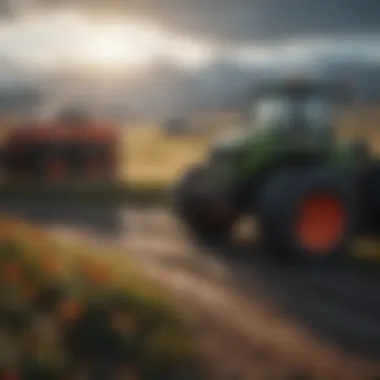Navigating Online Orders for Arctic Circle Products


Intro
The Arctic Circle provides unique items related to agriculture that are not easily found elsewhere. This article will explore the intricacies of online procurement, including selecting the right products, understanding supply chains, and addressing sustainability concerns.
As online shopping evolves, so do the methods and tools available for purchasing. Gaining insight into these aspects is not just beneficial—it's necessary for anyone involved in agriculture today.
Foreword to Online Ordering
In recent years, online ordering has become a pivotal aspect of various industries, especially in agriculture. This section discusses the significance of introducing the concept of online ordering in the context of acquiring Arctic Circle products. The convenience provided by digital platforms reshapes how agricultural products are procured, making it essential for farmers to understand the nuances of this process.
Defining Online Ordering
Online ordering refers to the process of purchasing goods or services through electronic platforms. This method allows customers to select products, make payments, and arrange for delivery without the need for physical interaction. In the case of Arctic Circle products, these platforms typically feature an array of items, including sustainable agricultural supplies and equipment suited for unique climate conditions.
Importance in Contemporary Agriculture
The modern agricultural landscape demands efficiency and responsiveness. Online ordering facilitates this by offering farmers immediate access to a wide range of products from various suppliers. Key advantages include:
- Time-Saving: Farmers can place orders at their convenience without the need to travel to physical stores.
- Diverse Selection: Online platforms often feature a broader range of products than traditional retail locations.
- Cost-Effectiveness: Competitive pricing often translates to better deals on essential supplies.
- Up-to-Date Information: Farmers can access the latest product reviews and specifications, aiding informed decision-making.
Furthermore, this approach aligns with sustainable practices by reducing the carbon footprint associated with traditional supply chains.
"The shift to online ordering in agriculture not only increases efficiency but also enhances sustainability efforts made by farmers."
This overview sets the groundwork for deeper exploration into the specifics of Arctic Circle products and how best to acquire them online.
Overview of Arctic Circle Products
The acquisition of Arctic Circle products encompasses a variety of items, each tailored for specific needs in agriculture. Understanding these products is fundamental for farmers and enthusiasts aiming to enhance their operations. This section will present the types of products available, as well as their unique features.
Types of Products Available
Arctic Circle offers a range of products across different categories. These include:
- Seeds: Core for agricultural growth, providing the foundation for successful harvests. The seeds are often specially cultivated to endure harsh conditions found in Arctic regions.
- Fertilizers: Customized nutrients designed to support plant growth in challenging environments. They are essential for maximizing yield and improving soil health.
- Tools and Equipment: From simple hand tools to advanced machinery, these products facilitate various farming techniques, ensuring efficiency in operations.
- Protective Gear: Items such as clothing and equipment that safeguard farmers while they work in often extreme weather conditions.
- Water Management Systems: These systems are crucial in regions where water scarcity is common, allowing for efficient irrigation practices.
Each type of product serves a distinct role in the Arctic agricultural ecosystem and helps address specific challenges faced by farmers in these unique environments.
Unique Features of Arctic Products
Arctic Circle products possess several unique characteristics that make them stand out:
- Adaptability: Many products are specifically designed to thrive in cold weather conditions. This adaptability makes them ideal for regions with shorter growing seasons.
- Durability: Given the harsher climate the Arctic poses, products are manufactured with materials that guarantee longevity and resilience against extreme weather.
- Sustainability: An increasing focus on eco-friendly practices means that many Arctic products emphasize sustainable sourcing. This commitment ensures that the ecological footprint is minimized, contributing positively to environmental considerations.
- Innovation: The development of these products often incorporates the latest technologies. This innovation ensures that farmers have access to tools and techniques that enhance productivity and efficiency.
The unique attributes of Arctic Circle products enable farmers to not only survive but thrive in some of the most challenging agricultural landscapes.
In summary, the availability of diverse and uniquely suited Arctic Circle products positions farmers to efficiently manage their operations while also working towards sustainable practices that support their environment.
Choosing Reputable Online Vendors
Selecting a reputable vendor is essential in the process of acquiring Arctic Circle products online. As the agricultural sector becomes increasingly reliant on digital platforms for procurement, it is vital to understand who the suppliers are and what they offer. A trusted vendor ensures not only the quality of the products purchased but also the reliability of the entire purchasing process. This choice can impact not just immediate agricultural operations but also long-term sustainability practices.
Evaluating the credentials of an online vendor involves several facets. This includes assessing their history, reading reviews from other customers, and looking into any certifications or associations they may hold. Vendors with a proven track record demonstrate stability and trustworthiness. It's crucial to avoid vendors that seem overly eager without much background information available.
Another significant aspect revolves around transparency. How clear is the vendor about their sourcing practices? Do they provide detailed specifications for their products? Consumers should seek vendors who make this information readily available. This transparency not only builds trust but also showcases the vendor's commitment to sustainability and ethical practices.
"Quality does not only lie in the product itself but also in the integrity of those who sell it."


Additionally, reputable vendors often have robust customer service provisions. They should offer various channels for inquiries, including email support, phone assistance, or online chat. Effective customer service plays a crucial role if there are issues with products or deliveries. Knowing that support is just a click or call away offers reassurance during the purchasing process.
Evaluating Vendor Credibility
To evaluate a vendor’s credibility, first check if they have established a decent online presence. A well-maintained website with clear contact information is usually a good sign. Look for affiliations with trusted agricultural organizations. Certifications from groups like the North American Sustainable Agriculture Working Group can be indicative of a vendor's credibility. It's also beneficial to look at ratings on platforms like Reddit or Facebook, where real customers share honest feedback about their experiences.
Moreover, consider vendor reviews that focus specifically on Arctic Circle products. These insights can provide context on the product quality and customer satisfaction.
Comparing Product Offerings
When it comes to Arctic Circle products, comparing offerings from different vendors is crucial. Not all vendors carry the same product lines or ranges. Some might focus on organic products, while others could offer a broader spectrum that includes conventional alternatives. Understanding the product offerings allows farmers to select options that align with their operational practices and sustainability goals.
Consider various aspects while comparing.:
- Product Specifications: Check ingredient lists and sourcing details.
- Price Points: Different vendors may offer the same products at varying prices.
- Shipping Policies: Shipping costs and delivery times can influence purchasing decisions significantly.
The Ordering Process
The ordering process is a critical component in the transaction of acquiring Arctic Circle products online. This section aims to elucidate the specifics of online ordering, which not only facilitates ease of access to products but also ensures that the purchasing experience is efficient and satisfactory.
The digital marketplace has transformed traditional purchasing methods. It allows agricultural professionals to explore a wide range of products at their convenience. The advantages of online ordering include time savings, broader product choices, and the ease of making side-by-side comparisons of various products. However, it is essential to approach the ordering process with a clear understanding of the steps involved to ensure a smooth transaction.
Step-by-Step Guide to Ordering
- Research Products: Start by identifying the specific Arctic Circle products you need. Utilize multiple online platforms to gather information.
- Select a Vendor: Choose reputable vendors that specialize in Arctic Circle products. Pay attention to their customer reviews and reputation.
- Create an Account: Most vendors require creating an account before placing an order. Ensure that you provide accurate information, which will help with future orders.
- Add to Cart: Once you have selected your products, add them to your shopping cart. Double-check quantities and specifications for each item.
- Review Your Cart: Before proceeding to checkout, review your cart. Ensure that everything you selected is correct.
- Checkout: Follow the vendor’s process for checkout, where you will provide shipping details and select a delivery method.
- Confirm Payment: Select your preferred payment method and enter necessary payment details.
- Receive Confirmation: After completing your order, watch for a confirmation email from the vendor. This email serves as a record of your purchase.
Payment Options and Security
In online transactions, the selection of payment options is crucial for ensuring both convenience and security. Common payment methods offered by vendors include credit cards, digital wallets like PayPal, and sometimes bank transfers.
It is imperative to prioritize security when making online payments. Vendors should have secure payment gateways that encrypt sensitive information. Always look for indicators like a padlock symbol in the browser address bar or URLs that begin with "https://". This signifies that the connection is secure.
Moreover, familiarize yourself with the vendor’s policies regarding payment security. Many vendors provide buyer protection services, which can add an additional layer of security. Follow these best practices for online payments:
- Regularly monitor bank statements for unauthorized transactions.
- Use unique passwords for vendor accounts.
- Avoid using public Wi-Fi for transactions whenever possible.
Choosing the right payment method can impact not only the immediacy of the transaction but also your peace of mind during the purchasing process. Ultimately, the ordering process lays the foundation for a successful acquisition of Arctic Circle products.
Logistics of Delivery
The topic of logistics of delivery holds significant relevance in the context of acquiring Arctic Circle products online. Efficient logistics ensures that products reach customers in a timely manner while maintaining integrity; this is particularly crucial for agricultural products which may require specific handling conditions. Understanding this process can facilitate better decision-making for farmers and enthusiasts alike.
One of the main components of delivery logistics is the selection of appropriate shipping methods. It is essential to choose methods that align with the nature of the products being shipped. For instance, perishable items may need expedited shipping options which prioritize speed over cost. Conversely, non-perishable items might be sent through more economical options. As such, farmers should assess their product types before choosing a shipping strategy.
In addition to shipping methods, accurate tracking systems play a vital role in logistics. Real-time tracking allows customers to monitor their orders from the moment they leave the vendor's location to the time they arrive at their doorstep. This transparency not only builds trust but also enables farmers to make necessary arrangements to receive their goods.
Key elements to consider in logistics of delivery include:
- Timeliness: Ensuring that products arrive when needed, especially for time-sensitive agricultural inputs.
- Cost Efficiency: Balancing the costs of shipping with the value of the products.
- Condition upon Arrival: Maintaining the quality of products throughout their journey.
"Effective delivery logistics can greatly influence the success of online procurement. Farmers should prioritize understanding this process to enhance their operations."
Understanding Shipping Methods
Shipping methods are fundamental to the logistics of delivery. Different products may necessitate specific shipping options. For instance,
- Air Freight: Ideal for perishable goods or high-value items that require swift delivery.
- Ground Transportation: Commonly used for bulk shipments and non-urgent items.
- Sea Freight: Often used for international shipments, this method is cost-effective for large quantities but slow.


Farmers should consider these options based on urgency, cost, and product type.
Tracking and Managing Shipments
Tracking shipments is a central element of customer satisfaction. It involves the ability to see the status and location of goods at any point during transport. Efficient management of shipments helps ensure products are not only delivered but delivered on time.
To effectively manage shipments, farmers can utilize logistics tracking software. Many vendors offer integrated solutions that provide updates on shipment status through mobile apps or websites. Moreover, managing communication with shipping providers can help address potential issues before they impact the delivery.
Quality Assurance in Online Purchases
Quality assurance plays a critical role in online purchases, especially in the context of procuring Arctic Circle products. When farmers and agricultural enthusiasts engage in online ordering, they expect not only the availability of desired products but also a guarantee of their quality. This assurance affects their willingness to purchase, trust in vendors, and overall satisfaction with the product received.
First, understanding product quality involves evaluating specifications, sourcing practices, and brand reputation. Farmers often rely on the nutritional value, durability, and ecological impact of products. Assessing these factors ensures they make informed decisions that align with sustainable practices. Additionally, consumers typically check for certifications or endorsements that provide independent verification of product quality before making a commitment to purchase.
Moreover, vendors who prioritize quality assurance usually have robust systems for quality control, thereby instilling confidence in the customer. This commitment not only enhances customer loyalty but also reinforces vendor reputation in a competitive marketplace. When searching for Arctic Circle products online, it is prudent to choose vendors known for their quality assurance protocols.
"Quality assurance is not just a goal; it is a necessity for ensuring satisfaction and trust in online purchases."
Assessing Product Quality Before Purchase
Before proceeding with an online order, assessing product quality is fundamental for making informed purchases. This process can involve several key steps:
- Review Product Specifications: Check the details provided by the vendor, including ingredients, manufacturing processes, and usage instructions.
- Examine Customer Reviews: Feedback from previous customers can provide insights into the product's effectiveness and reliability.
- Verify Certifications: Look for labels that ensure environmental or organic farming practices, as these often indicate a commitment to quality.
- Request Samples if Possible: If available, samples can offer a first-hand experience of the product before a full purchase.
By focusing on these aspects, farmers can ensure they procure high-quality products that meet their specific agricultural needs.
Returns and Refund Policies
Returns and refund policies are a pivotal element of the purchasing process in online transactions. When acquiring Arctic Circle products, understanding these policies can significantly affect consumer confidence and satisfaction. Here are several key considerations regarding returns and refunds:
- Clarity of the Policy: Ensure that the vendor clearly outlines the terms for returns, including timeframes, conditions, and processes.
- Condition of Received Product: Know your rights concerning the state of the product upon delivery. It should match the description provided when purchasing.
- Customer Support: Reliable vendors usually provide straightforward channels for addressing issues related to returns and refunds.
- Documentation: Always keep a record of your transactions and any correspondence concerning returns to facilitate swift resolutions.
Understanding these policies can help mitigate concerns regarding online purchasing risks, ensuring that consumers feel secure in their buying decisions.
Environmental Considerations
Impact of Online Purchasing on Sustainability
The impact of online purchasing on sustainability can be profound. Digital platforms encourage the availability of Arctic Circle products, facilitating easier access to ecologically sound offerings. Conversely, the shipping of products can result in higher carbon footprints. Factors such as packaging materials, transportation methods, and distance traveled must be scrutinized.
To illustrate:
- Carbon Emissions: Rapid delivery methods often lead to increased emissions. Choosing slower shipping options can mitigate this.
- Packaging Waste: Online orders commonly utilize excess packaging, which adds to landfills. Opting for products with minimal or recyclable packaging is vital.
- Local Sourcing: Supporting vendors who prioritize local goods can reduce transportation demand and enhance community sustainability.
The multiplier effect of online purchasing decisions reflects on the broader ecological balance. Consumers have the power to influence environmental conservation through their choices.
Best Practices for Eco-Friendly Orders
Achieving eco-friendly online ordering involves conscious decision-making at several steps. Implementing best practices can significantly enhance sustainability efforts:
- Choose Reputable Vendors: Select vendors known for sustainable practices. Research their methods of sourcing and transportation.
- Utilize Green Shipping Options: If available, select eco-friendly shipping methods. Some companies offer carbon offsetting choices for deliveries.
- Minimize Returns: Accurate product descriptions and customer reviews can help ensure that purchases satisfy needs, thereby reducing return rates. Returns often necessitate additional transportation and packaging.
- Consolidate Orders: Placing fewer, larger orders instead of multiple small ones can decrease transportation impacts while taking advantage of bulk purchasing benefits.
In summary, being mindful of environmental impacts during online purchasing can greatly contribute to sustainable agricultural practices.
By integrating these practices, farmers can make significant contributions to the preservation of delicate Arctic ecosystems while maintaining productive agricultural operations.
Integrating Online Orders into Agricultural Practices


The impact of online ordering on agricultural practices is substantial. As farmers look for efficiency in their operations, understanding how to effectively integrate online orders into their daily routines becomes crucial. The digital marketplace not only simplifies the procurement process but also allows for more thorough product selection. By embracing technology, farmers can find products tailored to their unique needs, which can enhance productivity and profitability.
Streamlining Procurement for Farmers
The procurement process is often a bottleneck in agricultural operations. Online ordering streamlines this process significantly. Farmers can access various suppliers and products from one platform. This accessibility enables them to compare prices and review product specifications without physically visiting multiple stores.
Additionally, farmers can use online tools to track their orders in real-time. Such visibility strengthens inventory management. They can schedule orders based on their supply needs, minimizing waste and ensuring that they always have what they require on hand.
Another benefit to online procurement lies in timeliness. With seasonal demands, being able to order products swiftly can make a critical difference. Farmers can respond quickly to changing conditions, sourcing what they need in real-time through easy-to-use interfaces.
Incorporating New Products into Farming Techniques
Innovation plays a key role in modern agriculture. The ability to order new products online allows farmers to experiment with cutting-edge tools and methods that can improve their yields. Many online vendors offer educational resources such as how-to guides, product reviews, and video demonstrations. This information can aid farmers in deciding which new products might integrate well into their existing practices.
Moreover, once a product is acquired, farmers can easily provide feedback or share their experiences with peers. These interactions foster a community of knowledge-sharing, enabling more farmers to learn about successful implementation strategies.
Adopting new products can also promote sustainable farming practices. By sourcing from vendors who prioritize eco-friendly solutions, farmers can advance their sustainability goals while also benefiting from improved agricultural outcomes. This innovation could range from utilizing organic fertilizers to new irrigation technologies.
In summary, integrating online orders into agricultural practices represents a transformational shift that benefits efficiency, knowledge-sharing, and sustainability. As the agricultural landscape continues to evolve, farmers who embrace this shift will likely find themselves better equipped to face the demands of modern farming.
Case Studies on Successful Online Ordering
Exploring case studies in online ordering is essential for understanding best practices and innovative approaches in the procurement of Arctic Circle products. These real-world examples highlight various methods that farmers and agricultural enthusiasts have used to streamline their purchasing processes while optimizing their operational efficiency. Analyzing these case studies not only provides valuable insights into vendor reliability but also underlines the strategies that lead to successful online transactions.
Reviewing Leading Vendors
When considering the acquisition of Arctic Circle products, it is critical to evaluate various vendors.
- Vendor Reputation: Leading vendors such as Arctic Harvest and Northland Fresh have established a solid reputation in the agricultural community. Their commitment to quality and service is evident through customer reviews and ratings.
- Product Availability: A thorough review of inventories can reveal the breadth of products these vendors offer, from organic fertilizers to bioengineered seeds designed for Arctic conditions.
- User Experience: An intuitive website interface, easy navigation, and customer service accessibility are essential features that continue to attract buyers to these platforms.
These aspects not only enhance the purchasing experience but also build trust and reliability in the vendor's brand.
Lessons from Agricultural Innovators
Understanding how innovative farmers approach online ordering can provide direction for others seeking to enhance their own practices.
- Adapting to Technology: Farmers like Anna Green from Greenland Farms have integrated online ordering systems with their existing supply chain logistics. This integration allows for a seamless transition from one system to another, reducing delays.
- Implementing Data Analytics: Utilizing data analytics, many agricultural innovators track their purchasing habits and optimize the types of products they acquire. This strategy has shown improved procurement efficiency.
- Networking with Peers: Engaging with community forums and platforms such as Reddit has enabled farmers to share experiences and recommendations regarding successful vendors and efficient ordering practices.
Future of Online Ordering in Agriculture
The landscape of agricultural procurement is rapidly evolving, with online ordering emerging as a pivotal element in modern farming. This transformation is driven by various factors, including technological advancements, consumer demands, and the necessity for sustainable practices. As farmers and agricultural enthusiasts increasingly rely on digital platforms for their supplies, understanding the future of online ordering is paramount. It not only facilitates access to hard-to-find Arctic Circle products but also streamlines various agricultural practices, enhancing productivity and efficiency.
One major benefit of online ordering is the vast range of products available at the fingertips of users. Unlike traditional methods, farmers can now source specialty items or regional goods that were previously inaccessible. Additionally, convenience plays a significant role; the ability to browse and order from home saves both time and resources that can be allocated elsewhere on the farm.
Emerging Trends and Technologies
In the realm of online agriculture, several trends are beginning to take shape. One prominent trend is the integration of Artificial Intelligence (AI) in sourcing and logistics. AI-powered tools can analyze buying patterns, suggest relevant products, and even forecast demand, making the procurement process more efficient.
Another trend is the rise of mobile commerce, as many farmers are shifting to smartphones for purchases. Mobile-friendly platforms and applications allow for on-the-go ordering, ensuring that farmers can purchase essentials regardless of where they are on their land. This accessibility is crucial for maintaining productivity, especially during peak seasons.
Blockchain technology is also gaining traction, particularly in tracking the supply chain of agricultural products. By enhancing transparency, blockchain can build trust between vendors and consumers, ensuring that the Arctic Circle products ordered are authentic and meet quality standards.
Predictions for the Next Decade
As we look toward the next decade, several predictions emerge regarding online ordering in agriculture. The increased adoption of e-commerce will likely lead to a reduction in the prices of many essential products. Competitive pricing models and the ability to compare vendors online should drive down costs, allowing farmers to purchase needed goods at more affordable rates.
Furthermore, sustainability will take center stage in the online marketplace. Expect a surge in demand for eco-friendly and ethically sourced products. As awareness grows around climate change and sustainable practices, consumers will increasingly favor vendors who prioritize these values.
Lastly, we may observe the fusion of augmented reality (AR) with online shopping. This technology could enable a virtual experience where farmers can visualize new products in their farming environments before making a purchase. Such innovations would not only enhance the buying experience but also optimize the selection process, helping to avoid unsuitable choices.
"The future of online ordering in agriculture is not just about convenience; it is about creating a sustainable and efficient ecosystem that benefits both farmers and the environment."
In summary, the future of online ordering in agriculture holds immense potential. As new technologies and trends emerge, farmers must adapt their strategies and embrace digital solutions to position themselves optimally in a competitive market.



